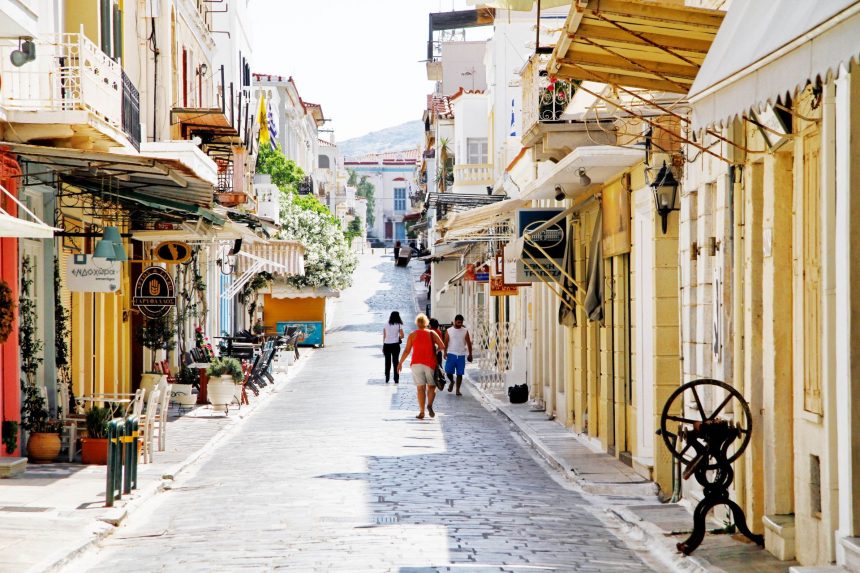- The monastery of Zoodochos Pigi. Just above the site of the tourist accommodation is the monastery of Zoodochos Pigi or Moni Agia in the position “Kapsorachi”, between Batsi and Gavrio and is one of the oldest monasteries of the Cyclades.
- Venetian castle. “Kato Kastro” is located on the edge of the peninsula of Chora, with which it was connected through the stone arched bridge that is preserved to this day, known as “Arch”. The fort provided protection to inhabitants of the country from the pirate raids that abounded in the Aegean. In 1943 it was bombed by the Nazi air force and a large part of it was destroyed.
- Tower of Agios Petros, in Ano Agios Petros. It is located near the village of “Agios Petros” and is the most well-preserved ancient monument of the island. Hellenistic times are mentioned as a possible construction period, i.e. the 4th or 3rd century BC, while in another opinion it was built during the Mycenaean era. Cylindrical tower, made of slate. It has a base diameter of 9.40 m, while its height reaches 20 m.
- Tower of Makrotantalos. It is also referred to as the Castle of “Ostodosia”. A typical example of Venetian defensive architecture on the island. It is located on the rocky edge of Pyrgos beach at the northern end of the west coast.
- Vryokastro, in Varidi. Parts of the fortifications are preserved here. It was used to protect the inhabitants from raids.
- Kastellaki, in “Gides“. Fortified area, opposite the Kalokairini settlement.
- Friktoria, Agia Marina area, Makrotantalou. Tower from where messages were sent. Today, part of the base of the Tower is preserved.
- Byzantine monastery of Sotiros, in the Municipal District of Vitaliou.
- Paleopolis archaeological site. In 1830, the first excavation effort took place in the area. In 1832, Hermes of Andros and a headless female statue were discovered and transferred to the Archaeological Museum of Athens.
- The ancient Zagora. The ancient settlement of Zagora is located on the steep plateau (height 160 m.) of the homonymous peninsula.
- Archaeological site of Aprovatou (Aprovato). After excavations in the area, ruins of a settlement were found and a fortified acropolis with an archaic temple in its center was identified.
- Apoikia with the famous spring “Sariza”.
- Apaturia with its stone bridges, beautiful mansions, and the impressive stream of Pythara.
- Stenies, the village of the captains, with its picturesque streets, the communal laundry, and the old pasta factory with the largest watermill in the Balkans.
- Mesaria, economic and commercial center of the Byzantine times, with the church of Taxiarchis Michael.
- Lamyra, a green village with abundant running water.
- The Byzantine monasteries of Panachrantos and Agios Nikolaos. The first perched on Mount Katafygi and the second near Achla beach.
- In Aladinou Municipal District of Mesaria, the Foros cave.
- The Castle of Faneromeni in the Municipal District of Korthi. It was built in the Middle Ages to protect against pirates.
- Dipotamata is a valley of great natural beauty, approximately 7 kilometers long, in the south-eastern region of the island, between Syneti, Paleokastro and Kokhylos.
- The Peristeriones. You will find these unique examples of popular architecture in large numbers in the area of the Municipality of Korthi.
- The church of Agia Triada in Korthi, where the first pre-revolutionary school in Andros operated. It has rich relics and manuscripts.
- The Byzantine churches of Ag. John the Theologian and St. Nikolaou in Korthi and Agios Georgios in Farali, on the provincial road of Kapparia.
- The watermills. More than 40 watermills are preserved in the Korthi area, excellent examples of pre-industrial technology. Most of them are in Dipotamata, but there are also in Edonia, Vouni, Piso Meria.
- The old mansion Agadaki Tower in Chora.
OTHER CULTURAL MONUMENTS – HISTORICAL & RELIGIOUS


